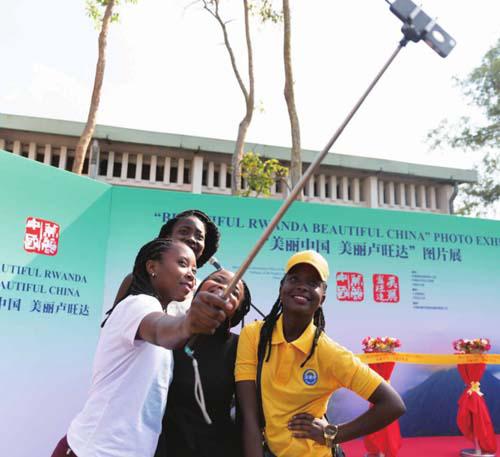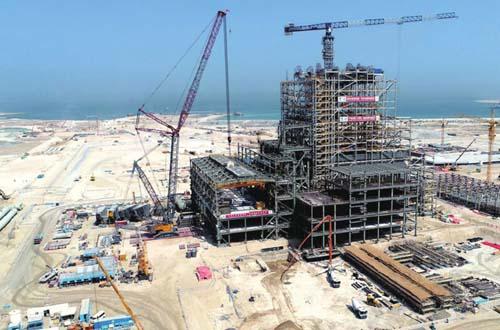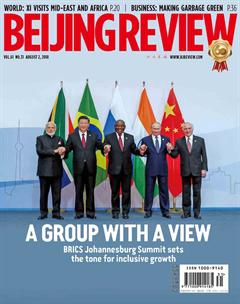Long-Distance Relationships
By Ma Miaomiao


Nothing, not even mountains, oceans or thousands of miles, can separate those with the same goal. The centuries of history shared between China and Middle East and Africa has formed the basis for deepening pragmatic cooperation across various fields in recent years, with bilateral and multilateral ties closer than ever in the new era.
With profound changes taking place in the international situation, Chinese President Xi Jinping paid state visits to the United Arab Emirates (UAE), Senegal, Rwanda and South Africa, attended the 10th BRICS Summit in Johannesburg, and visited Mauritius during a stopover from July 19 to 28.
On the eve of the 2018 BRICS Summit and ahead of the Forum on China-Africa Cooperation (FOCAC) Beijing Summit in September, Xis visit to the fi ve nations, also the fi rst overseas trip since his reelection as president in March, marked the opening of a new chapter for relations between China and other developing countries.
The trip cemented Chinas role and its determination to safeguard international economic and political security against the backdrop of mounting anti-globalization and protectionism, as well as deepening ties with African countries, said He Rui, an assistant researcher with the China Institute of International Studies (CIIS).
Belt and Road cooperation
Xis visit to the UAE was the first by a Chinese president in 29 years. With a unique geographic position, the UAE is regarded as a natural partner of China under the Belt and Road cooperation framework to push for concerted efforts to boost common development.
The UAE is the fi rst Gulf state to forge a strategic partnership with China. In recent years, bilateral cooperation has witnessed rapid, comprehensive, results-oriented development. China has been the UAEs largest trading partner for several years, while the UAE is now Chinas second largest trading partner and the primary destination of its exports in West Asia and North Africa. The volume of bilateral trade stood at $41 billion in 2017.
One of the first countries to embrace the China-proposed Belt and Road Initiative, the UAE is also a founding member of the Asian Infrastructure Investment Bank. The Silk Road Fund, established in 2014, has been financing infrastructure projects in Dubai, including the Hassyan Clean Coal Project. The $3.3-billion plant will provide 20 percent of Dubais future energy mix once put in operation, with a target set for completion before 2020. The station, notable as the fi rst green energy partnership in the Middle East, will add to the growing number of successful projects made possible by the Belt and Road Initiative.
In a declaration jointly issued by China and the UAE during Xis visit, the two nations agreed to upgrade their bilateral relations to a comprehensive strategic partnership and strengthen cooperation under the framework of the Belt and Road Initiative. In the document, the two nations expressed their willingness to establish a sustainable trade and investment partnership to achieve their common interests. The two sides pledged to increase trade and reinforce their complementary advantages, better facilitate investment, jointly promote the construction of a free trade zone, and turn their capacity cooperation demonstration zone into an example of joint projects under the framework of the Belt and Road Initiative. The two sides also pledged to hold conferences and symposiums themed on jointly building the Belt and Road Initiative.
The China-proposed Belt and Road Initiative, with the aim of promoting common development, is also popular among countries in Africa. Senegal is the fi rst West African country to sign a Belt and Road cooperation document with China. China is now Senegals second largest trading partner and the largest source of financing, while China-funded projects such as the Foundiougne Bridge and the Thies-Touba Highway are set to boost the countrys economic growth. A planned China-assisted rural water supply project in Senegal including 251 wells and 1,800 km of pipelines has the potential to benefi t one seventh of its population.
In a signed article in the Senegalese newspaper Le Soleil before setting foot on Senegalese soil, Xi called for further deepening practical cooperation between China and Senegal under the framework of the Belt and Road Initiative. “Leveraging the Belt and Road Initiative and the platform of FOCAC, China will work with Senegal to tap our respective strengths in the trade and processing of agricultural and aquatic products, infrastructure, production capacity, industrial parks and human resources development, all of which are important for Senegals capability to achieve home-grown development,” the article said.
When meeting Xi, Senegalese President Macky Sall spoke highly of the Belt and Road Initiative, saying his country stands ready to vigorously participate in connectivity construction, enhance cooperation in areas such as infrastructure construction, water conservation, industrialization, agricultural product processing, tourism, culture and sports.
Rwanda was the second African nation to sign a Belt and Road agreement with China. Two-way trade between China and Rwanda reached $157 million in 2017, an increase of 10.56 percent year on year. A project funded by China to drill 200 wells will help ease water shortages for over 110,000 people, while the construction of 70 percent of Rwandas national highways has been undertaken by a Chinese company.
China welcomes the participation of African nations in international cooperation, and encourages more countries on the continent to capitalize on the resources and funds available through the Belt and Road Initiative, so as to conduct pragmatic cooperation and maintain sustainable development, Liu Naiya, a senior researcher with the Institute of West-Asian and African Studies under the Chinese Academy of Social Sciences, told Beijing Review. He believes that the China-proposed initiative can help the African continent develop at a quicker pace.
Community with a shared future
It is believed that Xis five-nation trip will contribute to the building of a community with a shared future for China, Africa and all of mankind, said Liu.
His visit to Africa reaffirms Chinas policy of sincerity, tangible results, affi nity and good faith with regard to countries on the continent, as well as reaffirming the view that righteousness and benefi t should serve as guiding principles to strengthen China-Africa exchanges, develop multilateral relationships and expand pragmatic cooperation across various fi elds, Liu added.
China has always regarded developing countries as the cornerstone of its diplomacy, with Africa its priority. China and Africa have a deep-rooted friendship and a shared pursuit for development and prosperity, with China the worlds largest developing country and Africa home to the largest number of developing countries. Strengthening unity and cooperation with nations in Africa is an important basis of Chinas foreign policy and a long-term strategy for the Chinese Government, said Xi while meeting with Rwandan President Paul Kagame.
The two presidents agreed to further promote bilateral cooperation in the interests of the Chinese, Rwandan and African people. China has participated in the construction of infrastructure in East Africa, especially in key projects such as standard gauge railways, highways and power plants, all of which have benefi ted Rwanda.
In an article published on CRI Online, Wang Zhan, a researcher on foreign studies with Wuhan University, pointed out that all 10 major China-Africa cooperation plans launched at the FOCAC Johannesburg Summit in 2015 have effectively supported African industrial and agricultural development and accelerated Africas industrialization. Capacity cooperation has been a boon for the economic development of many African countries, and the construction in Africa of almost 100 industrial parks as well as the establishment of free trade zones has facilitated win-win cooperation between China and the continent. The volume of trade between China and Africa is expected to reach $400 billion by 2020 with efforts from both sides.
In Rwanda, Xi and Kagame agreed to strengthen the alignment of the two countries development strategies, give full play to complementary advantages, and carry out pragmatic cooperation in more areas and at deeper levels. They also agreed to promote people-to-people exchanges, deepen law enforcement and security cooperation, maintain close coordination on international and regional issues, and strengthen collaboration on issues of global signifi cance. As the rotating chairperson of the African Union (AU), Kagame also expected China to play an important role in supporting AU reforms and promoting Africas development.
This year marks the 20th anniversary of the establishment of diplomatic ties between China and South Africa, which have already in this short time grown into a comprehensive strategic partnership. On the economic front, China has been South Africas largest trading partner for nine consecutive years, while South Africa is Chinas largest trading partner in Africa. Their bilateral trade amounted to over $39 billion in 2017, more than 26 times its value back in 1998. South Africa is also Chinas largest investment destination in Africa; nearly 100 major Chinese enterprises have started business operations in South Africa with direct investment of $15 billion over the past years, with 2017 alone witnessing investment of $1.83 billion from China.
During talks between Xi and South African President Cyril Ramaphosa, both leaders agreed to strengthen high-level exchanges, deepen political trust, align development strategies, promote practical cooperation and increase people-to-people exchanges, thus enabling the peoples of the two countries to enjoy more benefi ts.
Xi stressed that China and South Africa should increase coordination within multilateral frameworks including those of the UN, the G20 and BRICS, jointly safeguard multilateralism, oppose unilateralism and protectionism, and promote a more just and equitable international order.
Liu said that Xis visit has also helped to lay the groundwork for the FOCAC Beijing Summit in September. According to him, by bringing together the Belt and Road Initiative, the UN 2030 Agenda for Sustainable Development, the AU Agenda 2063 and the national development plans of various African nations, the summit will break new ground for China-Africa cooperation.
He of the CIIS said that the synergy of the Belt and Road Initiative and FOCAC can push China-Africa cooperation to new heights, and both platforms complement each other well. The existing FOCAC mechanism and the integrity of the FOCAC framework will serve as a useful reference for future cooperation within the structures of the Belt and Road Initiative. In the meantime, inter- and trans-regional cooperation under the Belt and Road Initiative will benefit the bilateral and multilateral ties of developing countries.
Since the establishment of FOCAC in 2000, China-Africa trade has maintained steady growth, rising from $765 million in 1978 to more than $170 billion in 2017, an increase of more than 200 times.

